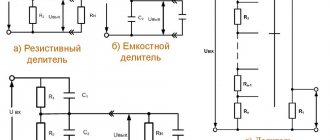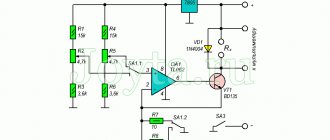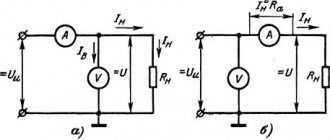When working in electrical installations, with hand tools, and even when using household electrical appliances, there is a danger of electric shock. To do this, it is not necessary to grab the bare section of the wire under the influence of electric current. Touch tension can be harmful to health and pose a direct threat to life.
Touch voltage
Definition of the concept
The word “touch” itself expresses the essence of this concept. Voltage is the potential difference between two points. It occurs due to insulation breakdown, induced static electricity or an emergency in the technological process. Touch voltage is electricity that appears on the human body as a result of its contact with points that have different potentials.
If in some place conditions are created for simultaneous touching of two conductive elements, then when a living organism appears there, we can talk about the danger of touch voltage. This electrical quantity can be preliminarily measured in order to have an idea of its expected maximum values.
Is touch voltage safe?
The potential difference resulting from various reasons sometimes reaches several hundred volts. To clarify, we can give an example when a person touches a grounded part of equipment that, for some reason, suddenly becomes energized. One of the potentials (ϕ1) is applied to the legs, the second (ϕ2) – at the point of contact with the equipment. The touch voltage value will be equal to:
Step voltage
U = ϕ1 – ϕ2.
If the obtained values are small, there will be no harm to health. However, as you move away from the equipment grounding point, in this case the U value will increase and reach a maximum where the area of electricity spreading from this grounding point ends.
The presence in the area of current spreading when the wire touches the ground is dangerous for a person to be injured by step voltage. If you experience discomfort when trying to step, you must reduce the step distance to a minimum. You can get out of the danger zone either by jumping on one leg, or by walking without lifting your soles off the ground and placing your feet as close to one another as possible.
Attention! Touch voltage above 42 V AC is dangerous to human life and health. If direct electricity reaches 120 V or more, touching it also poses a significant health hazard.
Violation of the insulation of live cables or wires and simultaneous contact of the human body with grounded metal structures and an area with damaged insulation will lead to electrical injury.
Danger from touch voltage
Conditional touch voltage limit
Conventional touch voltage limit is the maximum value of the expected touch voltage, the duration of which is not limited under certain external conditions. This definition is based on GOST R IEC 60050-195-2005. In this standard, this term is called differently - “permissible touch voltage”. Designated as UL.
The conditional touch voltage limit sets the value of the maximum expected touch voltage that can occur in the electrical installation of a building for an unlimited period of time. This voltage should generally not exceed the extra-low voltage upper limit of 50 VAC and 120 VDC. However, if electrical equipment is used in an environment where there is an increased risk of electric shock, the specified maximum expected touch voltage values are usually reduced to reduce the likelihood of electric shock.
Ways to reduce the danger
GOST 12.1.038-82 (2001) dated March 01, 2021 is the main regulatory document that is used to guide when taking the necessary measures. This GOST considers the standards for the maximum possible values of touch voltage.
Induced voltage
To ensure electrical safety for people, the following steps apply:
- installation of protective grounding devices;
- zeroing of working equipment;
- installation of potential equalization systems (EPS);
- fencing and installation of protective shields on live equipment;
- use of reduced voltage in work in areas with increased danger and especially dangerous ones;
- providing personnel with collective and individual protection items: insulated power tools and dielectric means;
- use of residual current devices (RCDs) and alarms.
Grounding devices are designed to protect against phase-to-frame short circuits. They are installed to reduce the voltage between the ground and live parts of electrical installations.
Important! All metal parts of installations, engines, switchboards, consoles, metal housings of power tools and other elements accessible to touch that can conduct current are subject to mandatory grounding.
To protect against extraneous voltage in places where connection to the ground loop is impossible, grounding is used. Using a separate conductor, the device body is connected to a grounded zero. When a phase hits it through this conductor, the short-circuit protection device is triggered.
To reduce the risk of electric shock to people, industrial and domestic premises are equipped with potential equalization systems (PES). They are basic (OSUP) and additional (DOSUP). The main system is independent and provides potential equalization on accessible metal surfaces of the equipment. DOSUP takes additional measures to reduce the level of potential difference in particular cases.
The implementation of protective fences and the installation of shields protect people from accidental contact with live parts. As an additional measure, warning posters are posted on the fences.
In places with increased danger and particularly dangerous work can only be done with power tools whose supply voltage is not higher than 42 V. For this, step-down transformers are used.
Information. Rooms with increased danger include those where there are: a chemically aggressive environment, high humidity (more than 70%), elevated temperature (above 500C), accessible contact with metal parts or concrete floors.
Collective and personal protective equipment (PPE) includes: dielectric mats and stands, boots, galoshes, gloves and tools with insulating handles. The use of such protective kits reduces the risk of touch voltage.
RCD - residual current devices installed in the apartment allow you to control the occurrence of current leaks and dangerous voltage in places with increased danger (kitchen, bathroom). When dangerous quantities appear, the device turns off the power supply until the cause of their occurrence is eliminated.
A way to reduce the risk of electrocution
Step and touch tension
Category: Manufacturing equipment
Electric shock is possible when touching the grounded body of electrical equipment to which a short circuit has occurred. In this case, when a person touches both the energized body and the ground on which he is standing, he may find himself under touch voltage U.
Touch voltage is the potential difference between two points in a current circuit that are simultaneously touched by a person.
The potentials on the ground surface when the current is shorted to the body of any consumer are distributed along a hyperbolic curve. The touch voltage is equal to the potential difference between the body of electrical equipment and the points of the soil on which a person’s feet are located. The further the electric motor is from the ground electrode, the higher the touch voltage a person is exposed to, and vice versa, the closer to the ground electrode, the lower the touch voltage U. Outside the current spreading zone, the touch voltage is equal to the voltage on the equipment body relative to ground.
Rice. Scheme of a person touching grounded equipment at touch voltage:
I-potential distribution on the ground surface at the moment of phase closure to the body; II - touch voltage U when the distance from the ground electrode changes; 1,2,3 — electric motor housings
The touch voltage and the amount of current flowing through the human body during normal (non-emergency) operation of an alternating current electrical installation with a frequency of 50 Hz should not exceed 2 V and 0.3 mA, respectively.
The touch voltage and current can be reduced by using a low resistance of the protective grounding system or increasing the surface potential in the area where the current flows to the ground.
If there are conductive floors or soil, a person located close to the body of the electrical equipment to which the current has shorted may be exposed to step voltage U. Step voltage occurs around the point where the current passes from the damaged electrical installation to the ground.
Step voltage is the voltage between two points of the current circuit, located one step apart from each other, on which a person is simultaneously standing.
The nature of the distribution of potentials on the earth's surface obeys the hyperbolic law.
At a distance of 1 m from the place where the current flows to the ground, the potential decreases by 68%, at a distance of 10 m the reduction reaches 92%, and at a distance of 20 m the potential of the ground points is almost zero. This distribution of potentials is explained by the fact that near the ground electrode the area of the conductor-ground is small, so here the ground offers great resistance to the passage of current. As you move away from the ground electrode, the cross-section of the ground conductor increases, its resistance decreases, and therefore the voltage drop decreases. At a distance of more than 20 m from the point of current closure, the ground offers virtually no resistance to the passage of current.
A person, being in the area of current flow, without even touching the damaged equipment, can become exposed to high voltage.
This happens because different points on the earth that a person's feet touch have different potentials.
From the equality it follows that the step voltage depends on the fault current, the step width, the distance from the person to the place where the current is faulted to the ground, as well as on the resistivity of the soil. As you move away from the fault, the step voltage becomes less.
The maximum value will be when a person stands with one foot on a piece of ground at the point of the current shorting to the ground, and the other at a distance of a step from this point. The minimum value corresponds to the case when a person stands on points with equal potentials, with his legs tightly closed. In this case = 0.
Step tension is the cause of frequent death of people and large animals (cows, horses). If a connection to the ground of any current-carrying part of the installation is detected, it is prohibited to approach the place of damage at a distance closer than 4 m in rooms and closer than 10 m in open areas.
It should be noted that the nature of the dependence of the step voltage on the distance between a person and the ground electrode is opposite to the same dependence of the touch voltage, which increases with increasing distance.
Without taking into account additional resistance in the human electrical circuit, the maximum step voltage is less than the touch voltage. However, the defeat of people when exposed to step voltage is explained by the fact that under the influence of current, cramps occur in the legs and the person falls, after which the current circuit closes along his body through the respiratory organs - the lungs and heart, which leads to paralysis of their activity.
Once in the step voltage zone, you should exit it with small steps (goose-stepping steps) in the direction opposite to the place of the suspected ground fault and, in particular, to the wire lying on the ground.
Calculation of touch voltage
By performing calculations, the possible value of the current in case of contact is determined. For calculations, two electrical network diagrams are considered:
- circuit with solidly grounded neutral;
- system with isolated neutral.
Electrical voltage
In the first case, when a person is exposed to phase voltage (220 V), the amount of current through it is restrained by the resistance of the circuit: phase - body - shoes - floor (ground). Based on this, the formula looks like:
Ich = Uph/(Rch + Rob + Rp + R0) ≈ Uph / Rch,
Where:
- R0 – resistance of the transformer neutral protective conductor, R0 ≤ 10 Ohm;
- Uph – phase voltage;
- Rch – human resistance;
For linear voltage, the flow current is calculated using the formula:
Ich = Ul/√3*( Rch + Rob + Rp + R0).
In the second case, where the neutral is isolated, they work with the formulas:
- Ich = Ul/Rch – for the moment of two-phase contact;
- Ich = 3Uph/(3Rch + Riz) – a variant of single-phase contacting, where Riz is the insulation resistance of the phase wires in relation to the ground.
Note! If the ground electrode is singular, then touching the body of the device furthest from it will be the most dangerous.
Measurement methods
The measurements are carried out by a visiting team of a special laboratory that has a license to perform such measurements. Work and non-work places are measured. Measurements are carried out at an ambient temperature of 5-400C and air humidity of 35-80%.
Measuring circuit at the workplace
Attention! The workplace is the area of operation of operational personnel within the framework of the regular work process. A non-work place is an area where there may be people who are not performing official duties related to work in electrical installations.
Before making measurements, the neutral conductor is disconnected from the shield to preliminary measure the resistance of the grounding loop. Next, when assembling the measurement circuit, one output of the device is connected to the protective grounding bus, and the second to the current electrode. Maintaining a distance of more than 25 m from the ground electrode, drive the pin into the ground and install a plate on which a load of 50 kg is placed. This is an imitation of a human leg. The soil under the plate is moistened. The voltmeter V monitors the touch voltage, the resistance R = 1 kOhm is equivalent to the resistance of the human body.
When performing measurements at non-working places, the terminal of the T2 device must be connected to the grounding point of the equipment housing located nearby.
The placement of the current electrode must be done so that the artificial reproduction of the phase voltage ground fault circuit is as accurate as possible.
Another measurement method is a circuit using a voltmeter and an ammeter.
The first tests the touch voltage, the second shows the amount of current flowing through the ground electrode. The power source of the measuring circuit is a transformer with an output voltage of 500 V and a rated power of 100 kVA.
Ammeter and Voltmeter Testing
How to measure touch voltage
NP measurement is carried out using a voltmeter and ammeter. If it is not possible to ground one point with the secondary winding, then install an isolation transformer and ground this contact again, that is, create conditions of maximum “danger”.
You might be interested in what 1 ampere is equal to in kilowatts
Calculations are carried out by qualified electrical laboratory specialists for testing installations. Before measurements, conductors are checked for constant current, resistance and continuity of wiring.
INP is carried out at a temperature not lower than +5 degrees. The electrical installation must be completely installed and connected to the existing network. The test current is 50% of the rated current. By connecting the modern measuring device MI 3102H CL to the necessary parts of the electrical installation, measurements are taken.
Measuring device
Important! If the maximum voltage value is exceeded, check the grounding resistance.
After all the procedures performed, the measurement results are documented in the form of a protocol.
Single ground
This is the simplest type of equipment grounding, in which there is no need to construct a special circuit. Nevertheless, it is a very effective protective component that allows the protective shutdown to operate and “bypass” a person who has come under voltage.
Single protective earthing includes:
- grounding electrode 2500 mm long - angle steel 50*50*0.5 mm or pipe with a diameter of at least 4 mm;
- grounding conductor - rolled steel wire with a diameter of at least 0.8 mm outdoors and 0.6 indoors or a steel strip 25 mm wide and 0.5 mm thick;
- The connection point for the grounding conductor is a bolt for connection on the electrical installation body.
As a grounding conductor indoors, it is permissible to use a flexible stranded copper wire of yellow-green color, with a cross-section of at least 2.5 mm. All connections are made using electric welding. The seams are at least 10-15 mm long. Welding areas and metal grounding parts (except for the electrode driven into the ground) are painted with black paint to protect against corrosion.
Important! The minimum grounding resistance for a 220 V network should be no more than 8 Ohms, for a three-phase 380 V line the minimum value of R ≤ 4 Ohms.
The ground electrode is driven or buried into the ground so that its upper part is 0.4-0.5 m below ground level.
Group grounding
A grounding loop is formed from single grounding conductors. They are placed in one row or in the form of a geometric figure to reduce the overall resistance of the structure. Calculations are made in advance, as a result of which the required number of elements in the circuit is determined.
Information. The distance between adjacent electrodes in the circuit is maintained equal to the length of the electrode. This is due to the fact that the maximum efficiency of a single ground electrode (90%) is achieved by its area of action. The zone includes all points equidistant from it at a distance of its length. The areas of action of the nearest grounding conductors should not intersect.
Ground loop
Types of electrical injuries
Electrical injuries occur due to the action of an arc or current. There are local or general damage to the body.
With local exposure to electricity on the human body, the following may occur:
- burns;
- metallization of the skin;
- electrical signs;
- burn of the cornea of the eyes;
- mechanical injuries to the skin and soft tissues.
They do not pose a danger to life; treatment of local affected areas of the body is required. The exception is burns - if the percentage of damage to the skin surface is too high, death is possible.
The severity of an electric shock depends on the path the electricity takes through the victim's body. There are five degrees of electric shock, which results in the following consequences:
- weak, involuntary muscle contraction - cramps are barely noticeable;
- convulsions with severe pain;
- lack of consciousness without failure of the heart and respiratory organs;
- lack of consciousness with loss of breathing and heartbeat;
- clinical death.
Note! The outcome depends on how quickly the person is freed from the effects of electricity and how successfully medical care is provided.
Paths of current passing through the human body
Main causes of electric shock
1. Accidental contact with live parts that are energized as a result of:
erroneous actions during work;
malfunction of protective equipment.
2. The appearance of voltage on metal structural parts of electrical equipment as a result of:
damage to the insulation of live parts;
network phase short circuit to ground;
falling of a live wire onto structural parts of electrical equipment, etc.
3. The appearance of voltage on disconnected live parts as a result of: erroneous switching on of a disconnected installation;
short circuits between disconnected and energized live parts;
lightning discharge into an electrical installation, etc.
4. The occurrence of step voltage on a piece of land where a person is located, as a result of:
phase-to-ground fault;
removal of potential by an extended current-carrying object (pipeline, railway rails);
malfunctions in the protective grounding device and others.
Step voltage and touch voltage
In any electrical networks, a person located in the current spreading zone may be exposed to step voltage and touch voltage.
Step voltage (step voltage)
is called the voltage between two points of the current circuit, located one step apart from each other (0.8 m) and on which a person is simultaneously standing.
The highest electrical potential will be at the point where the conductor touches the ground. As you move away from this place, the potential of the soil surface decreases, since the cross-section of the conductor (soil) increases in proportion to the square of the radius, and at a distance of approximately 20 m it can be taken equal to zero. The danger of step voltage increases if the person exposed to it falls: step voltage increases, since the current no longer passes through the legs, but through the entire human body.
The tension of touch
is called the voltage between two points in a current circuit that are simultaneously touched by a person. The danger of such a touch is assessed by the value of the current passing through the human body, or by the voltage of the touch and depends on a number of factors: the circuit diagram of the current circuit through the human body, the network voltage, the circuit of the network itself, the mode of its neutral (i.e., whether the neutral is grounded or isolated), the degree of insulation of live parts from the ground, as well as the value of the capacitance of live parts relative to the ground, etc.
Prevention
In a timely manner, at least 2 times a year, it is necessary to measure the protective grounding and the phase-zero loop at workplaces.
Eliminate the following causes of electrical injuries:
- failure to comply with safety regulations;
- being near a broken wire;
- contact with exposed parts of electrical installations under power;
- touching parts of equipment that suddenly become energized;
- touching elements of electrical appliances with damaged insulation.
Electrical safety training must be carried out at workplaces.
What is meant by touch voltage?
| Voltage between two conductive parts or between a conductive part and ground when simultaneously touched by a person or animal | Correct answer |
| Voltage between two points on the ground due to the spreading of a fault current to the ground when they are simultaneously touched by a person’s feet | Incorrect answer |
| The voltage produced when current flows through a conductor between two points | Incorrect answer |
| Voltage between two points on the surface of the earth at a distance of 1 m from one another, which is taken to be equal to the length of a person’s step | Incorrect answer |
| Voltage between two points in an electrical circuit with different potentials | Incorrect answer |
Which of the following grounding systems belongs to the TN ?
| A system in which the neutral of the power supply is isolated from earth or is grounded through high-resistance instruments or devices, and the exposed conductive parts of the electrical installation are grounded | Incorrect answer |
| A system in which the neutral of the power source is solidly grounded, and the exposed conductive parts of the electrical installation are grounded using a grounding device electrically independent of the solidly grounded neutral of the source | Incorrect answer |
| A system in which the neutral of the power source is solidly grounded, and the open conductive parts of the electrical installation are connected to the solidly grounded neutral of the source via neutral protective conductors | Correct answer |
In which electrical installations are dielectric gloves used as the main insulating electrical protective equipment?
| In electrical installations up to 1000 V | Correct answer |
| In electrical installations over 1000 V | Incorrect answer |
| In all electrical installations they are used as the main insulating agent | Incorrect answer |
| In all electrical installations they are used as an additional insulating agent | Incorrect answer |
TICKET 18
Who is covered by the Rules for the Technical Operation of Consumer Electrical Installations?
| For organizations, regardless of ownership and legal forms, individual entrepreneurs operating existing electrical installations with voltages up to 220 kV inclusive, and citizens who own electrical installations with voltages above 1000 V | Correct answer |
| For organizations, regardless of ownership and legal forms, operating existing electrical installations with voltage up to 220 kV inclusive | Incorrect answer |
| For organizations, regardless of ownership and legal forms, individual entrepreneurs operating existing electrical installations with voltage up to 220 kV inclusive, as well as for electrical installations of power stations, block stations | Incorrect answer |
| For organizations, regardless of ownership and legal forms, individual entrepreneurs operating existing electrical installations with voltages up to 380 kV inclusive, and citizens who own electrical installations with voltages above 380 V | Incorrect answer |
In which electrical installations is a person responsible for electrical equipment appointed?
| In all electrical installations, regardless of owner | Incorrect answer |
| In all electrical installations, except those where the owners of electrical installations above 1000 V are citizens | Incorrect answer |
| In all electrical installations, except those where the owners of electrical installations above 1000 V are citizens or the electrical equipment includes only ASU, lighting installations and electrical equipment with a voltage not exceeding 380 V | Correct answer |
| In all electrical installations, except those where the electrical equipment includes only ASU, lighting installations and electrical equipment with a voltage not exceeding 380 V | Incorrect answer |
What are the requirements for posted personnel?
| They must have professional training | Incorrect answer |
| They must be trained and certified in electrical safety and assigned the appropriate clearance group | Correct answer |
| They must be trained and certified in occupational health and safety, if necessary. | Incorrect answer |
| Personnel must be at least 18 years of age | Incorrect answer |
What training should seconded personnel receive upon arrival at their destination?
| Introductory and primary on electrical safety | Correct answer |
| Introductory, primary on electrical safety and target on labor protection | Incorrect answer |
| Introductory, primary and target on electrical safety | Incorrect answer |
| Introductory, primary and target on electrical safety and labor protection | Incorrect answer |
In which electrical installations can work be performed as part of routine operation?
| In electrical installations with voltages up to 1000 V | Correct answer |
| In electrical installations with voltages up to and above 1000 V | Incorrect answer |
| In any electrical installations | Incorrect answer |
In what cases is it permissible to use non-standardized measuring instruments?
| If there is permission from the manufacturer | Incorrect answer |
| If there is permission from Rostekhnadzor authorities | Incorrect answer |
| If these means have passed metrological certification in the prescribed manner | Correct answer |
| If there is permission from the Consumer's manager | Incorrect answer |
In circuits with what voltage should the current be measured?
| In circuits with voltages up to 1000 V | Incorrect answer |
| In circuits with voltages over 10 kV | Incorrect answer |
| In circuits of all voltages, where it is necessary for the systematic control of a technological process or equipment | Correct answer |
| In all electrical circuits | Incorrect answer |
What is the frequency of visual inspection of the visible part of the grounding device?
| According to schedule, but at least once a month | Incorrect answer |
| According to schedule, but at least once every three months | Incorrect answer |
| According to schedule, but at least once every six months | Correct answer |
| According to schedule, but at least once every nine months | Incorrect answer |
| According to schedule, but at least once a year | Incorrect answer |
In which electrical installations do you need to wear dielectric gloves when using a voltage indicator?
| In electrical installations with voltages above 380 V | Incorrect answer |
| In electrical installations with voltages up to 1000 V | Incorrect answer |
| In electrical installations with voltages above 1000 V | Correct answer |
| In electrical installations with voltages above 10 kV | Incorrect answer |
Which of the following posters are warning signs?
| Do not turn on! People are working. | Incorrect answer |
| Working under voltage. Do not turn it on again! | Incorrect answer |
| Grounded. | Incorrect answer |
| Carefully! Electrical voltage. | Correct answer |
TICKET 19
Which electrical receivers belong to the second category electrical consumers?
Weather and external conditions
Grounding connections are tested in winter during the period of greatest freezing of the soil and in summer when the soil is most dry at the locations of the protective contours. The resistance value of the grounding device, which means its effectiveness, depends on the condition of the soil. If we take into account that the potential difference from static electricity during a thunderstorm can reach values above a thousand volts, then the potential equalization system (EPS) must withstand such loads.
It is impossible to completely eliminate potential differences. There is always a danger of exposure to touch voltage. Compliance with safety precautions and a set of protective measures will help reduce the risk of electric shock to a minimum.











